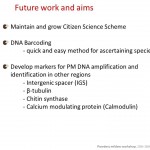Here is the presentation I delivered at the PM workshop, Kew on September 15th, 2014.
It was extremely different to the almost exclusively research-based presentations, but received much interest, avenues for future growth, and new powdery mildew samples.
Please click on the first slide and then cycle through………and then send some samples!
- ‘Avenues to impact’ or ways in which your research will affect the masses are now common goals in all research grant proposals…
- …however, they are rarely followed through on.
- The “Powdery Mildew Citizen Science Scheme” was launched via this blogpost on 21st May, 2014.
- There is a very real disconnect between the research that we do as scientists and public and government awareness and understanding. Schemes like this can help to keep us connected.
- This credit-card-sized flyer was disseminated with the help of the RHS at flower shows in Chelsea, Birmingham and Hampton Court.
- The scheme is also promoted via the Reading Herbarium Twitter page (@RNGherb).
- A montage of communications via Twitter (left) and Facebook (right).
- Articles from relevant socieites have also helped to spread the word (this one if from the BSBI http://bsbipublicity.blogspot.co.uk/2014/06/botanists-to-rescue-ii-we-need-your.html).
- A montage of blog posts.
- The launch blog includes info on how to send powdery mildew infected samples…
- …resulting in various samples; some of which really test the national postal service…
- …and others which are beaturifully presented. All samples however are equally useful.
- After morphological analysis, samples are stored with moisture absorbing silica gel, before DNA is extracted from them.
- As of 15/09/2104 33 samples from 13 locations across the UK have been received.
- Analysis of the host plant and important morphological features in both the sexual and asexual forms of the fungus helps to delimit the potential species.
- Complimenting morphology with the fungus’ DNA which is then matched to an online reference library (NCBI’s GenBank) helps to complete the identification.
- However not all of the ca. 800 PM species are present on this online resource. In such cases an ID to a tribe or genus level is sufficient and complimented with the morphology and host data.
- As well as continuing the scheme I must start to develop the principal aim of my project; developing molecular markers for ID.
- Don’t forget to send the samples!



















